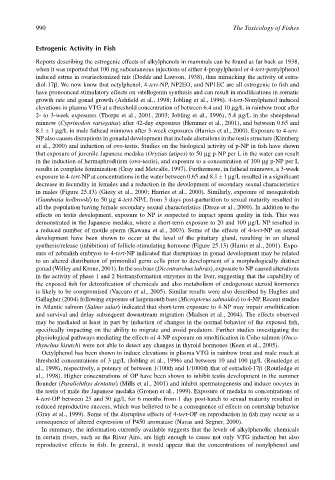Page 1010 - The Toxicology of Fishes
P. 1010
990 The Toxicology of Fishes
Estrogenic Activity in Fish
Reports describing the estrogenic effects of alkylphenols in mammals can be found as far back as 1938,
when it was reported that 100 mg subcutaneous injections of either 4-propylphenol or 4-tert-pentylphenol
induced estrus in ovariectomized rats (Dodds and Lawson, 1938), thus mimicking the activity of estra-
diol-17β. We now know that octylphenol, 4-tert-NP, NP2EO, and NP1EC are all estrogenic to fish and
have pronounced stimulatory effects on vitellogenin synthesis and can result in modifications in somatic
growth rate and gonad growth (Ashfield et al., 1998; Jobling et al., 1996). 4-tert-Nonylphenol induced
elevations in plasma VTG at a threshold concentration of between 6.4 and 10 µg/L in rainbow trout after
2- to 3-week exposures (Thorpe et al., 2001, 2003; Jobling et al., 1996), 5.4 µg/L in the sheepshead
minnow (Cyprinodon variegatus) after 42-day exposures (Hemmer et al., 2001), and between 0.65 and
8.1 ± 1 µg/L in male fathead minnows after 3-week exposures (Harries et al., 2000). Exposure to 4-tert-
NP also causes disruptions in gonadal development that include alterations in the testis structure (Kinnberg
et al., 2000) and induction of ovo-testis. Studies on the biological activity of p-NP in fish have shown
that exposure of juvenile Japanese medaka (Oryzias latipes) to 50 µg p-NP per L in the water can result
in the induction of hermaphroditism (ovo-testis), and exposure to a concentration of 100 µg p-NP per L
results in complete feminization (Gray and Metcalfe, 1997). Furthermore, in fathead minnows, a 3-week
exposure to 4-tert-NP at concentrations in the water between 0.65 and 8.1 ± 1 µg/L resulted in a significant
decrease in fecundity in females and a reduction in the development of secondary sexual characteristics
in males (Figure 25.13) (Giesy et al., 2000; Harries et al., 2000). Similarly, exposure of mosquitofish
(Gambusia holbrooki) to 50 µg 4-tert-NP/L from 3 days post-parturition to sexual maturity resulted in
all the population having female secondary sexual characteristics (Dreze et al., 2000). In addition to the
effects on testis development, exposure to NP is suspected to impact sperm quality in fish. This was
demonstrated in the Japanese medaka, where a short-term exposure to 20 and 100 µg/L NP resulted in
a reduced number of motile sperm (Kawana et al., 2003). Some of the effects of 4-tert-NP on sexual
development have been shown to occur at the level of the pituitary gland, resulting in an altered
synthesis/release (inhibition) of follicle-stimulating hormone (Figure 25.13) (Harris et al., 2001). Expo-
sure of zebrafish embryos to 4-tert-NP indicated that disruptions in gonad development may be related
to an altered distribution of primordial germ cells prior to development of a morphologically distinct
gonad (Willey and Krone, 2001). In the sea bass (Dicentrarchus labrax), exposure to NP caused alterations
in the activity of phase 1 and 2 biotransformation enzymes in the liver, suggesting that the capability of
the exposed fish for detoxification of chemicals and also metabolism of endogenous steroid hormones
is likely to be compromised (Vaccaro et al., 2005). Similar results were also described by Hughes and
Gallagher (2004) following exposure of largemouth bass (Micropterus salmoides) to 4-NP. Recent studies
in Atlantic salmon (Salmo salar) indicated that short-term exposure to 4-NP may impair smoltification
and survival and delay subsequent downstream migration (Madsen et al., 2004). The effects observed
may be mediated at least in part by induction of changes in the normal behavior of the exposed fish,
specifically impacting on the ability to migrate and avoid predators. Further studies investigating the
physiological pathways mediating the effects of 4-NP exposure on smoltification in Coho salmon (Onco-
rhynchus kisutch) were not able to detect any changes in thyroid hormones (Keen et al., 2005).
Octylphenol has been shown to induce elevations in plasma VTG in rainbow trout and male roach at
threshold concentrations of 3 µg/L (Jobling et al., 1996) and between 10 and 100 µg/L (Routledge et
al., 1998), respectively, a potency of between 1/100th and 1/1000th that of estradiol-17β (Routledge et
al., 1998). Higher concentrations of OP have been shown to inhibit testis development in the summer
flounder (Paralichthys dentatus) (Mills et al., 2001) and inhibit spermatogenesis and induce oocytes in
the testis of male the Japanese medaka (Gronen et al., 1999). Exposure of medaka to concentrations of
4-tert-OP between 25 and 50 µg/L for 6 months from 1 day post-hatch to sexual maturity resulted in
reduced reproductive success, which was believed to be a consequence of effects on courtship behavior
(Gray et al., 1999). Some of the disruptive effects of 4-tert-OP on reproduction in fish may occur as a
consequence of altered expression of P450 aromatase (Navas and Segner, 2000).
In summary, the information currently available suggests that the levels of alkylphenolic chemicals
in certain rivers, such as the River Aire, are high enough to cause not only VTG induction but also
reproductive effects in fish. In general, it would appear that the concentrations of nonylphenol and

